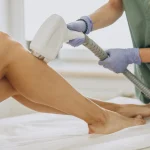
Dentist Clinics Teeth Cleaning: Step by Step to a Healthier Smile
August 11, 2025
Laser Hair Removal Dubai: Your Ultimate Guide to Smooth, Bare Skin
September 20, 2025Foot tendonitis is one of the leading causes of debilitating chronic pain in the foot and reduced mobility. Tendons are firm fibrous tissue that join bone and muscle, and when irritated or inflamed, ordinary actions like walking, running, or standing can become excruciating. Most individuals develop the condition due to overuse, sudden trauma, or poor biomechanics. If you experience tendon pain, the right treatment for sprained foot tendons at the right time needs to be undertaken in order to avoid any complications and to allow easy recovery.
What is Foot Tendonitis?
Foot tendonitis is the inflammation of one or more than one of the foot tendons. Because the foot is supplied with numerous tendons to serve as support towards movement, balance, and stability, any pain or injury would badly hinder your ability to exercise or walk.
The most frequent kind of foot tendonitis are:
- Achilles tendonitis – tendinitis of the tendon linking your calf muscle and bone at the back of your ankle.
- Extensor tendonitis – tendinitis of tendons at the front of your foot.
- Peroneal tendonitis – tendinitis of tendons on the outer side of the ankle.
- Posterior tibial tendonitis – involved in the tendon that supports the arch of your foot.
- Plantar fasciitis – not tendinosis of the tendons, but occasionally it behaves just like tendonitis with heel and arch pain.
Who’s at Risk?
Foot tendonitis may occur to anyone, although it is extremely prevalent among athletes, runners, and anybody whose job is to stand on their feet for hours. Other causes of foot tendonitis include:
- Overuse or repetitive stress of the foot.
- Insufficient stretching prior to or following exercise.
- Flat feet or foot structural deformity.
- Medical illness like arthritis, gout, or diabetes.
- Poorly supporting footwear.
- History of past foot or ankle injury.
Recreation and sports professionals also have special requirements, and thus sports orthopedic Dubai specialists’ clinics are most crucial.
What causes Foot Tendonitis?
Repeated stress on the tendons is the most common cause of foot tendonitis, but also acute trauma causes it. Recurring frequent causes are:
- Repetitive twisting or over-stretching of the foot.
- Abrupt alteration in activity levels.
- Poor running or walking stance.
- Tight or strained calf muscles.
- Sneakers that don’t provide arch or heel support.
Therapy of a sprained foot can be called upon in severe conditions in addition to tendon therapy for immobilizing the area.
Symptoms to Watch Out For
Symptoms of tendonitis will differ based on the tendon affected, but some of the common ones are:
- Pain over or along the tendon, or at the point where the tendon attaches to bone.
- Painful and inflamed regions.
- Morning stiffness after waking up from sleeping.
- More pain with more activity.
- Weakness or symptom of instability in the foot.
Otherwise, tendonitis can lead to tendon rupture or tearing and need more severe treatment by an orthopedic surgeon Dubai in order to recover.
Diagnosis of Foot Tendonitis
You need to be properly diagnosed so that the optimal treatment could be administered to you. The doctor will typically take a physical examination, which includes inspection for swelling, pain, and soreness. Imaging scans such as ultrasound or MRI are also used in determining the degree of the tendon injury.
Treatment Options for Foot Tendonitis
Tendonitis treatment varies with tendonitis severity. If it is not serious, it can be treated at home, but repeated injury or extreme injury must be hospitalized. The modal treatments are:
- Rest – Resting so that one does not work too hard.
- Ice treatment – Putting ice packs so as not to cause swelling and pain.
- Compression – Bandaging the foot so not to cause swelling.
- Elevation – Having the foot above the heart.
- Physical therapy – Mobility, strengthening, and flexibility exercises to restore.
- Orthotics – Personalized shoe inserts that stabilize the foot and distribute pressure.
- Medications – Non-narcotic pain medication can be prescribed.
- Immobilization – In extreme situations, a cast or walking boot has to be utilized.
For chronic pain, consultation with Dubai’s top orthopedic surgeon guarantees you get personalized treatment for your condition.
Preventing Tendon Injury to the Foot
Treatment will get you walking in a snap, but prevention is really the best medicine. To avoid tendon injury:
- Warm up prior to exercise and stretch afterwards.
- Use shoes that support the arch and heel.
- Avoid making rapid changes in physical activity.
- Keep weight as close to normal as possible in order to prevent stressing the feet.
- Keep calf and foot muscle strength with regular exercise.
These actions not only avoid treatment of the sprained tendons of the foot but also to the foot.
Final Thoughts
Being infected with foot tendonitis may lead to disruption in one’s regular routine, but through early treatment and proper technique of management, you are well on your path back to wellness. If you require professional treatment, alshifaalkhaleeji offers professional treatments for acute and chronic tendon disease. In case you require professional consultation, customized rehabilitation, or counseling by a seasoned orthopedic surgeon Dubai, our professionals are dedicated to making sure you enjoy the best treatment. Taking care of your foot today will make you active, pain-free, and confident tomorrow.
Foot tendonitis is the inflammation of one or more tendons in the foot, causing pain, swelling, and difficulty in walking or exercising.
Athletes, runners, people who stand for long hours, and individuals with flat feet, past injuries, or medical conditions like arthritis or diabetes are at higher risk.
Symptoms include pain along the tendon, morning stiffness, swelling, increased pain with activity, and weakness or instability in the foot.
Diagnosis involves a physical examination for pain and swelling, along with imaging tests such as ultrasound or MRI to assess tendon damage.
Treatment depends on severity and may include rest, ice therapy, compression, elevation, physical therapy, orthotics, medications, or immobilization for severe cases.




